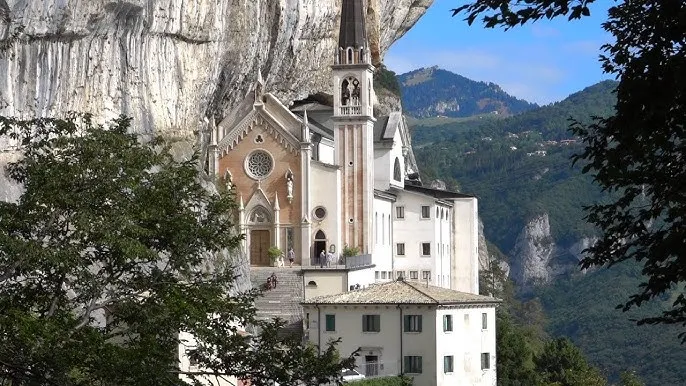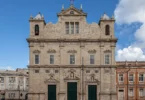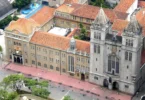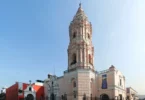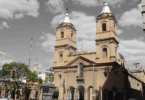Introduction
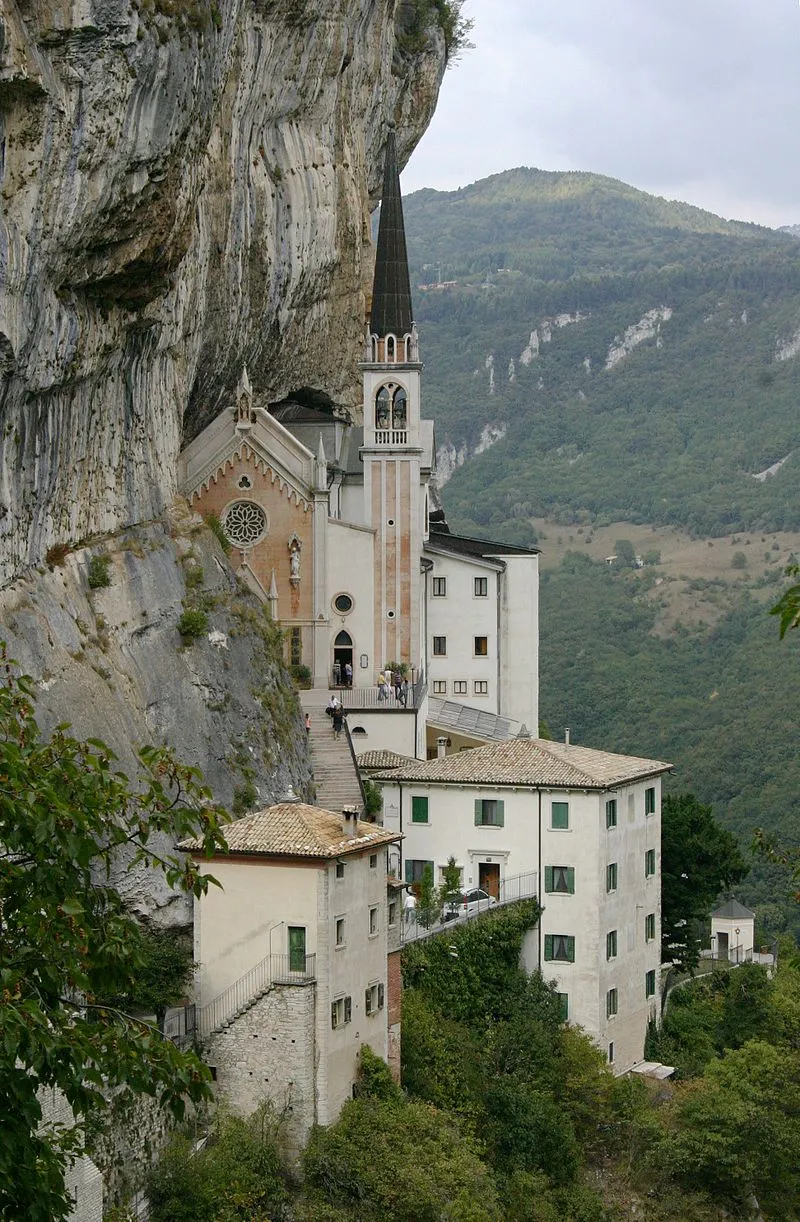
The Sanctuary of Madonna della Corona is situated in the municipality of Ferrara di Monte Baldo, in the province of Verona, within the diocese of Verona. This remarkable religious site is perched on the edge of a steep cliff, offering breathtaking views over the Val d’Adige. The sanctuary lies at an altitude of 775 meters above sea level, surrounded by the natural beauty of the mountainous region. It is located not far from the village of Spiazzi di Caprino Veronese, making it both a spiritual haven and a stunning destination for visitors seeking serenity and awe-inspiring landscapes. The sanctuary’s unique position, built into the rock, adds to its mystique and makes it one of the most iconic and visited religious sites in the area.
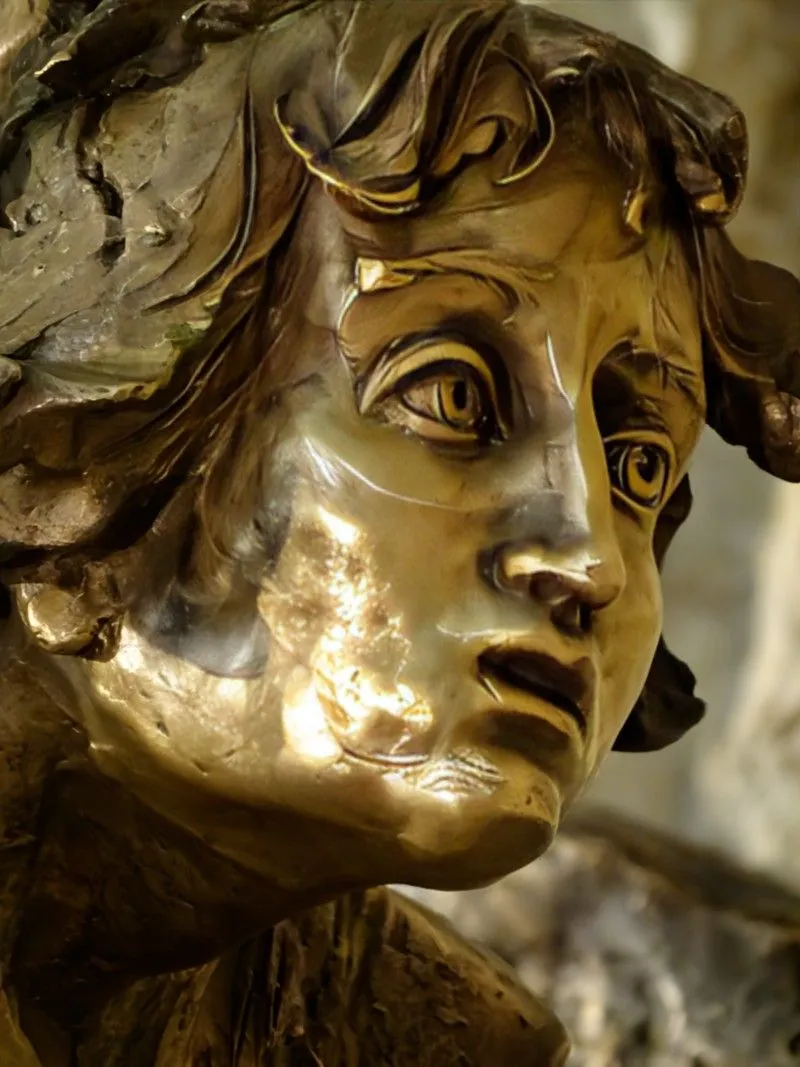
Origins of the Sanctuary
The origins of the Sanctuary of Madonna della Corona are steeped in a local legend that has become integral to its identity. The story revolves around the miraculous discovery of a statue of the Pietà, which was originally kept on the island of Rhodes. According to the legend, the statue was moved in 1522 to escape the invasion of the Turks under Suleiman the Magnificent and the plundering of the island’s treasures. It is said that the statue was transported by divine intervention, with an angel guiding it from Rhodes to Mount Baldo, where it was hidden in a rocky ravine, providing sanctuary from the turmoil.
The legend further tells that a group of local inhabitants witnessed a mysterious light shining on the rocky cliff and heard angelic voices emanating from the area. Intrigued, they lowered themselves down the cliff with ropes to investigate, finding the sacred statue. In awe of this miraculous event, the locals decided to build a chapel on the very spot where the statue was discovered. The story of this divine intervention quickly gained popularity, attracting an increasing number of pilgrims to the site. However, the chapel’s remote and precarious location made it difficult to access, prompting the construction of a path with the iconic “Ponte del Tiglio” bridge and steps carved into the rock to make the pilgrimage more accessible.
More likely, however, the sculpture of the Pietà was donated to the site by Lodovico Castelbarco, a nobleman from Rovereto, in 1432. The small stone sculpture, dating back to the early 15th century, is made from local materials and reflects the Vesperbild style, typical of the Alpine region. The origins of the legend may be connected to the Knights of Jerusalem, who were associated with the “Rodi” commandery. This hermitage dedicated to the Madonna in the rocky ravine may have been under their care in the 15th century.
Devotion and Pilgrimage
Devotion to the Madonna della Corona has deep roots, particularly within the Diocese of Verona and the surrounding Vicenza region, including the parishes of Lessinia. One of the most notable depictions of the Madonna della Corona’s history is a painting in the parish church of Sant’Anna d’Alfaedo, which illustrates the statue’s miraculous transport from Rhodes to the cliffs of Mount Baldo. Pilgrims have traveled to the sanctuary from various parts of Lessinia and Vicenza for centuries, with the route from the Vicenza area traditionally taking two days, as opposed to the shorter, one-day pilgrimage from Lessinia. The path followed by these pilgrims does not pass through the higher, winding roads of Lessinia, but instead takes a steep mule track that leads through the Parpari basin and up to the Veronese mountainside, passing through San Giorgio di Bosco Chiesanuova and Podesteria di Erbezzo. Pilgrims from Vicenza are customarily offered a local sweet at the Fittanze pass, marking an enduring tradition of hospitality.
Historical Attendance and Early Developments
The area where the sanctuary now stands has a history of religious significance dating back to the 11th and 12th centuries. Originally serving as a hermitage, it was home to hermits associated with the Abbey of San Zeno in Verona. By around 1200, a chapel dedicated to Santa Maria “de monte Bloto” was documented, indicating the early presence of religious activity in the area. The chapel, known as Santa Maria di Monte Baldo, was accessible only through a narrow and rugged path carved into the rock. In 1437, the sanctuary was entrusted to the Order of the Knights of Malta, who would oversee it for centuries. During their tenure, from 1480 to 1522, a larger church was constructed, measuring about 126 square meters. In the 16th century, further developments were made to improve accessibility to the sanctuary, including the creation of steps in the rock and the building of the “Ponte del Tiglio” bridge to facilitate the pilgrimage.
In 1625, the small church was officially elevated to the status of a sanctuary when the Knights of Malta oversaw a reconstruction, which was completed in 1680. The church was given the title “Sanctuary of Madonna della Corona,” a name inspired by the semi-circular shape of the surrounding rock formation. The construction of the new church involved extending the building by four meters above the original structure, which was incorporated under the presbytery.
Renovations and Recognition
As the number of pilgrims visiting the sanctuary continued to grow, the need for accommodation led to the construction of an adjoining hospice. The sanctuary underwent several renovations throughout the 19th and 20th centuries to accommodate the increasing influx of visitors. In 1898, the decision was made to expand the sanctuary by about two meters toward the square in front, and the façade was subsequently renovated in 1899. In 1975, significant renovation work began to modernize the sanctuary, including excavating into the rock to expand the church. The sanctuary was consecrated on June 4, 1978, and the completion of the renovation was celebrated with a visit from Pope John Paul II on April 17, 1988. In recognition of its religious and cultural importance, Pope John Paul II elevated the sanctuary to the status of a minor basilica in July 1982, further cementing its significance as a sacred site of pilgrimage and devotion.
Architecture of Sanctuary of the Madonna della Corona, Ferrara di Monte Baldo, Italy
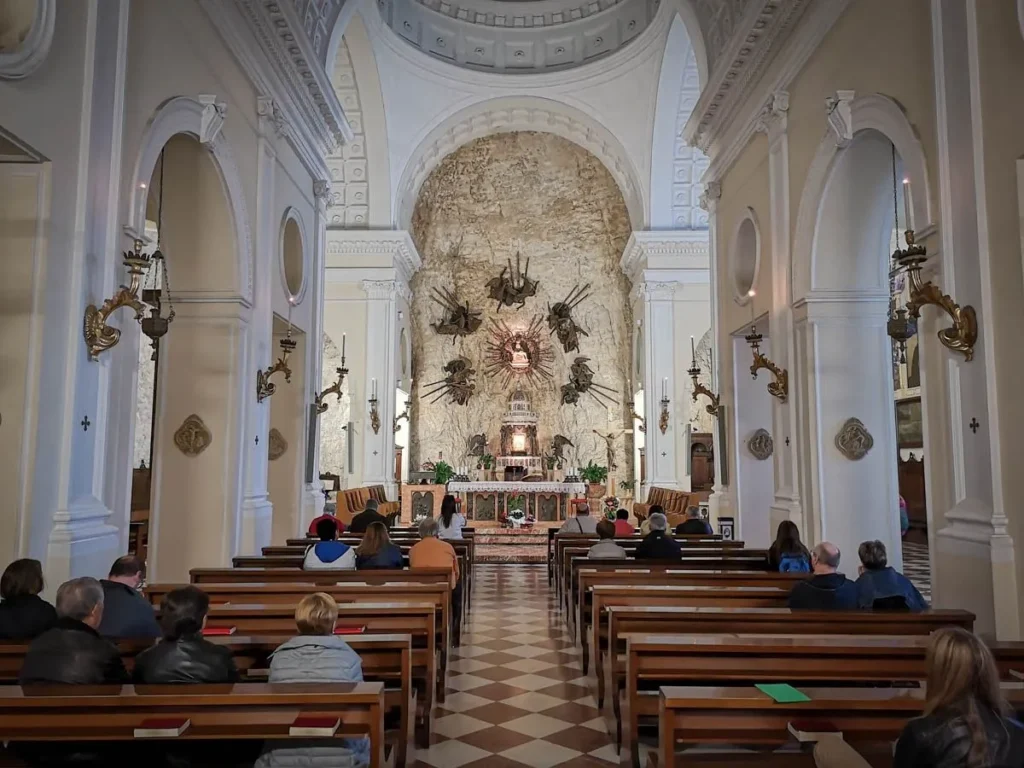
Architectural Features and Interior Design
The Sanctuary of Madonna della Corona is an awe-inspiring structure measuring 600 square meters, with a length of 30 meters, a width of 20 meters, and a dome rising 18 meters high. The building’s facade is designed in the neo-Gothic style, and it is beautifully adorned with Sant’Ambrogio marble. A 33-meter-high bell tower flanks the sanctuary, enhancing its vertical grandeur. The central entrance door is framed by two statues in Carrara marble, sculpted by Ugo Zannoni, which depict Saint John the Evangelist and Saint Mary Magdalene. These figures are positioned at the height of the tympanum, greeting visitors as they enter.
Inside the sanctuary, there are numerous significant works by local Veronese artists. One of the key pieces is the statue of Our Lady of Sorrows, located in the Chapel of the Confessions. This chapel, which lies beneath the main church, is connected to the upper sanctuary through the Holy Stairs. The sanctuary itself is divided into three naves, with the central nave standing 16 meters tall. Notably, the left nave and the apse are entirely carved into the rock, which gives the interior a unique and sacred atmosphere. In these rock-hewn spaces, visitors can view a representation of the Holy Shroud and the “Perfumed Stone”, a marble block soaked in nard oil. The “Perfumed Stone” is a symbol of the Christian faith, as the term “Christ” means “anointed.” Above the main altar rests the statue of the Madonna della Corona, donated by Lodovico Castelbarco in 1432. This sculpture, standing 70 centimeters tall, is inscribed with the Latin phrase: “HOC OPUS FECIT FIERI LODOVICUS D CASTROBARCO D 1432,” offering a precise date for its creation. The sanctuary also houses 167 ex-votos, the oldest of which dates back to 1547, illustrating the long-standing devotion of pilgrims to this sacred site. Additionally, the sanctuary is home to a 13th-century fresco depicting the Madonna with Child, believed to be the oldest sacred image venerated in the Madonna della Corona Sanctuary.
Sacellum Pietatis and Hermits’ Burial Ground
A short distance from the main sanctuary stands the Sacellum Pietatis, a small hexagonal temple. This structure marks the exact spot where, according to tradition, the miraculous statue of the Madonna was originally found. Its placement on this historically significant location adds to the sacredness of the area. Within the sanctuary complex is also the hermits’ burial ground, where the hermits who once lived and cared for the site were laid to rest. This quiet, contemplative space further emphasizes the deep spiritual history of the sanctuary.
The Bronzes of Raffaele Bonente
The sanctuary is home to several works by the renowned Veronese artist and architect Raffaele Bonente. Among his contributions are the bronze statues depicting the Via Crucis (Stations of the Cross) along the road leading to the sanctuary. These powerful sculptures invite pilgrims to reflect on Christ’s Passion as they approach the sacred site. Bonente also created a breathtaking scenography on the rocky wall of the apse surrounding the statue of the Pietà (Vesperbild). The statue is suspended in the center of the rock, encircled by a crown of thorns that emanates golden rays. Five groups of angels hover around the Pietà in a heavenly triumph, symbolizing both the sacrifice of Christ and the sorrow of the Virgin Mary.
In addition to this, Bonente designed several important elements within the sanctuary, including the panels for the high altar, the Annunciation panel on the pulpit, and a depiction of Christ in the baptistery. He also created all the stained glass windows, which represent the mysteries of the Holy Rosary, as well as a large crescent-shaped window displaying litanies dedicated to Mary Queen. Additionally, Bonente designed the Chapel of the Adoration, complete with its own stained glass windows, further contributing to the sanctuary’s spiritual atmosphere.
The Path to the Sanctuary
Reaching the sanctuary has always been a spiritual journey for pilgrims. Historically, it was accessible only by climbing 1,614 steps from the village of Brentino in Vallagarina. This challenging ascent made the pilgrimage a physically demanding yet spiritually fulfilling experience. Today, the sanctuary is also accessible via an asphalted road that begins near the village of Spiazzi and leads to a tunnel, dug into the rock in 1922. A painting of the Madonna is displayed at the end of this tunnel. While this road can only be traveled on foot, it provides pilgrims with a more accessible, though still spiritual, path. Along the way, visitors encounter the fourteen bronze stations of the Via Crucis, which guide them through Christ’s Passion, as well as a reproduction of the tomb where Jesus was placed after His death. The sanctuary also marks the endpoint of the Path of the Two Sanctuaries, a pilgrimage route that begins at the Sanctuary of Pieve di Chiampo, crosses seven valleys in the Venetian Prealps, and culminates at the Madonna della Corona Sanctuary. This journey enhances the pilgrimage experience, offering a scenic and deeply spiritual passage through the natural landscape.
Marian Devotion and Legendary Origins
The sanctuary is a place of deep Marian devotion, especially due to the veneration of the Pieta — a statue of the Virgin Mary holding the body of Jesus, which has made the site an important pilgrimage destination. According to tradition, the origins of the sanctuary date back to 1522, when the statue is said to have “miraculously” arrived from the island of Rhodes after the invasion of the Ottoman Empire by Suleiman I. However, this date conflicts with a 14th-century painting of the Madonna and Child in the sanctuary, which is considered the first venerated image at the original church.
The Statue of the Madonna della Corona
The statue of the Madonna della Corona is made of local colored stone, measuring 70 cm in height, 56 cm in width, and 25 cm in depth. It stands on a pedestal inscribed with the Latin phrase: “HOC OPUS FECIT FIERI LODOVICUS D CASTROBARCO D 1432,” confirming that the statue was commissioned by Lodovico Castelbarco of the Castelbarco family and presented to the church in 1432. This dates the statue precisely and adds a layer of historical significance to the sanctuary’s origins. The Madonna della Corona statue has long been a symbol of the sanctuary’s enduring spiritual significance, attracting countless pilgrims who come to venerate it in devotion to the Virgin Mary.
Feast Day
Feast Day : 08th September
The feast day of the Sanctuary of the Madonna della Corona is celebrated on September 8th, which is the Feast of the Nativity of the Blessed Virgin Mary. This day holds special significance for the sanctuary, as it honors the birth of the Virgin Mary, to whom the sanctuary is dedicated. Pilgrims and devotees gather to celebrate this important feast, participating in various religious ceremonies and prayers at the sanctuary in Ferrara di Monte Baldo.
Church Mass Timing
Monday : 10:30 AM., 3:30 PM.
Tuesday : 10:30 AM., 3:30 PM.
Wednesday : 10:30 AM., 3:30 PM.
Thursday : 10:30 AM., 3:30 PM.
Friday : 10:30 AM., 3:30 PM.
Saturday : 10:30 AM.,5:00 PM.
Sunday : 9:00 AM , 10:30 AM , 12:00 PM , 3:00 PM , 4:30 PM.
Church Opening Time:
Monday : 07:00 am – 7:30 pm.
Tuesday : 07:00 am – 7:30 pm.
Wednesday : 07:00 am – 7:30 pm.
Thursday : 07:00 am – 7:30 pm.
Friday : 07:00 am – 7:30 pm.
Saturday : 07:00 am – 7:30 pm.
Sunday : 07:00 am – 7:30 pm.
Contact Info
Address :
Sanctuary of the Madonna della Corona
Vicolo Santuario, 1, 37020 Spiazzi VR, Italy.
Phone : +390457220014
Accommodations
Connectivities
Airway
Sanctuary of the Madonna della Corona, Ferrara di Monte Baldo, Italy, to Valerio Catullo Airport (VRN), distance between 42 min (44.1 km) via A22/E45.
Railway
Sanctuary of the Madonna della Corona, Ferrara di Monte Baldo, Italy, to Avio Railway Station, distance between 40 min (36.3 km) via SS12 and SP11.

